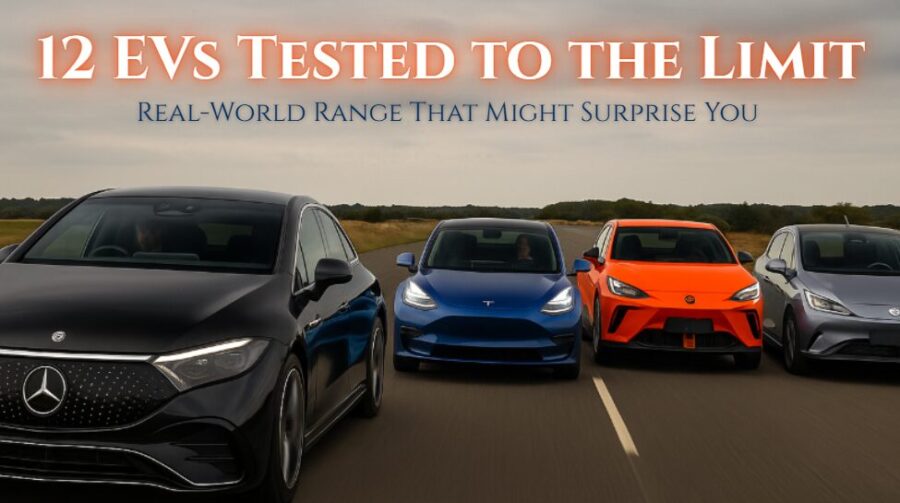4-Point Overview:
- 12 EVs, one real-world challenge: What Car? UK tested top EVs until they ran out of charge — no simulations, just facts.
- Mercedes EQE takes the crown with the highest real-world mileage, while Tesla Model 3 proves most efficient.
- Some newcomers like BYD Seal impressed, beating out legacy brands like Lexus and Jeep.
- The test reminds buyers: Range claims on paper don’t always match reality — trust what’s proven, not just what’s promised.
Intro: EV Hype vs. Reality
EVs are everywhere today — in headlines, on highways, and in glossy brochures claiming 500+ km ranges. But how far do they really go before calling it quits?
In a bold and brilliant move, the team at What Car? UK decided to skip the spreadsheets and take 12 electric vehicles out on the road — literally — until they dropped to 0%. From Teslas to BYDs to BMWs, these cars were driven continuously around the Millbrook Proving Ground in Britain, simulating real-life driving as accurately as possible.
The result? A surprise or two, and plenty of useful insights for anyone eyeing an EV in 2025.
The Big Test: Who Went the Distance?
The star of the test was none other than the Mercedes EQE, which clocked an impressive 300 miles before running out of juice. With a usable battery of 89 kWh and a claimed range of 380 miles, it performed admirably and showcased why the German brand is still king when it comes to long-haul luxury EVs.
But hot on its heels was the Tesla Model 3 Long Range, which traveled 293 miles with a smaller 75 kWh battery — making it the most efficient car in the test. Tesla may be facing stiffer competition these days, but it’s clearly not backing down when it comes to real-world usability.
Then came the surprise package: BYD Seal, an up-and-comer from China. With 255 miles achieved on an 82.5 kWh battery, it beat out names like BMW and Volvo, reinforcing BYD’s growing global reputation.
Full Results: EV Range Test Comparison
| Rank | EV Model | Usable Battery (kWh) | Tested Range (miles) | Claimed Range (miles) | Heat Pump |
|---|---|---|---|---|---|
| 1 | Mercedes EQE | 89 | 300 | 380 | Yes |
| 2 | Tesla Model 3 | 75 | 293 | 390 | Yes |
| 3 | VW ID.7 (Heat Pump) | 77 | 268 | 381 | Yes |
| 4 | BYD Seal | 82.5 | 255 | 354 | Yes |
| 5 | VW ID.7 (Standard) | 77 | 254 | 383 | No |
| 6 | BMW i5 | 81.2 | 253 | 338 | Yes |
| 7 | Volvo XC40 | 79 | 232 | 331 | Yes |
| 8 | MG4 | 74.4 | 227 | 323 | No |
| 9 | BYD Dolphin | 60.4 | 188 | 265 | Yes |
| 10 | Lexus UX 300e | 64 | 170 | 273 | No |
| 11 | Jeep Avenger | 50.8 | 163 | 244 | Yes |
| 12 | Lexus RZ 450e | 64 | 159 | 252 | Yes |
What Does This Really Mean?
Let’s be real — most people don’t drive their EVs until they drop dead. But tests like these give us a raw, honest look at how these cars perform when it really counts — whether you’re in stop-and-go traffic or heading out on a weekend road trip.
And the truth? Specs don’t always match reality. The Lexus UX 300e promised 273 miles but tapped out at just 170. On the flip side, Tesla and Mercedes stayed close to their claims, proving their premium price comes with real-world trust.
The surprise star? BYD’s Seal — budget-friendly, but impressively capable. It’s clear: EV success isn’t about brand flash — it’s about real-world results.
Conclusion: Choose What Works for You
What this EV showdown really shows is simple — brochure numbers only tell half the story.
If you’re thinking about buying an electric car in 2025, don’t just fall for flashy range claims. Instead, look for what actually holds up in the real world — whether it’s a rainy-day school run or a bumper-to-bumper commute home.
Sure, Mercedes and Tesla still set the bar high, but BYD and MG are making serious moves — and proving you don’t need to spend a fortune to get great performance.
At the end of the day, the best EV for you isn’t the one with the biggest number on a spec sheet — it’s the one that just works for your life. So go test it. Drive it. Charge it. Because the future of driving isn’t about who shouts the loudest — it’s about who shows up when it matters.

